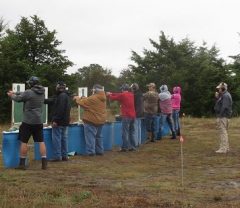What, really, is the difference between defensive shooting and competitive shooting? Most people would suggest that competitive shooters take a lot of time to make a surgically precise shot at a small target, and the defensive shooter needs to get a shot off within 3 seconds. True, but the real difference is that many defensive shooters do not have the same understanding of mental focus as do competitive shooters. That focus, or psychology, is as important for the 3-sec shot as for the 10-sec shot.
In pistol shooting, there are some basic fundamentals like stance, grip, extension, sight alignment, and breath control. While those are important, you can do those incorrectly (within limits) and still make that defensive shot that might save your life. Trigger control, however, is a different story. I have seen students who did the other fundamentals reasonably well, yet could not consistently put shots within an 18-inch group on a paper target at 7 yards. When you factor in the effects of crisis (panic, adrenaline, blood pressure, tunnel-vision), it is likely that person would have less than a 20% chance of making that shot. In fact, the FBI says police officers in a crisis only hit their target 25% of the time.
The other fundamentals require a mastery of the physical self, but trigger control requires a mastery of the psychological self. Most shooters know that the biggest perceived problem is recoil. In fact, recoil is not the direct problem, but an indirect one. By the time you feel recoil, the bullet has already left, so the real problem is anticipation of recoil. It is a natural human tendency to prepare for the coming dramatic event, so at the last moment, people grip the pistol harder, or change their stance, which causes the muzzle to move very slightly, and ruins the shot. This is a very common problem for all shooters, but especially newer shooters, who also often jerk the trigger so they will have a more precise idea of when the shot will break.
Instead, one must adopt the “tortoise and the hare” concept of the competitive shooter: slow and steady wins the race. Prepare the trigger (gently take up the slack in the trigger until the connector touches the sear; you will feel a stopping point), then gradually put pressure on the trigger until it breaks. Try to have no idea when the break will occur, and be surprised when it does. Continue to pull past that point until the trigger bottoms out on the frame. Do not respond to recoil until it happens; you can’t stop it anyway.
That last point is counter-intuitive, which is where mental focus comes into it. Imagine that you are standing against a wall, and someone is shooting an arrow at your head; I just told you to not duck until after the arrow hits you. That would make no sense, but that is exactly what I am telling you about recoil. Do not allow any change in the shooting process until the shot breaks. Yes, you know it is coming, but you can’t stop it. Learn to “ride the wave” up and back down, reacquire the target, shoot again. Always include these steps:
- Take up the slack
- Slowly squeeze, even when shooting rapidly
Bringing relaxation, calmness, and mental focus into the process has another benefit: besides allowing a more surgical precision and tighter groups, you will be better able to block out fear and debilitating physical responses, and create a mental tunnel-vision that may allow you to deal with the crisis at hand, and perhaps save your life.
